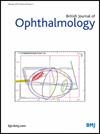Predicting the cognitive impairment with multimodal ophthalmic imaging and artificial neural network for community screening
IF 3.7
2区 医学
Q1 OPHTHALMOLOGY
引用次数: 0
Abstract
Background/aims To investigate the comprehensive prediction ability for cognitive impairment in a general elder population using the combination of the multimodal ophthalmic imaging and artificial neural networks. Methods Patients with cognitive impairment and cognitively healthy individuals were recruited. All subjects underwent medical history, blood pressure measurement, the Montreal Cognitive Assessment, medical optometry, intraocular pressure and custom-built multimodal ophthalmic imaging, which integrated pupillary light reaction, multispectral imaging, laser speckle contrast imaging and retinal oximetry. Multidimensional parameters were analysed by Student’s t-test. Logistic regression analysis and back-propagation neural network (BPNN) were used to identify the predictive capability for cognitive impairment. Results This study included 104 cognitive impairment patients (61.5% female; mean (SD) age, 68.3 (9.4) years), and 94 cognitively healthy age-matched and sex-matched subjects (56.4% female; mean (SD) age, 65.9 (7.6) years). The variation of most parameters including decreased pupil constriction amplitude (CA), relative CA, average constriction velocity, venous diameter, venous blood flow and increased centred retinal reflectance in 548 nm (RC548) in cognitive impairment was consistent with previous studies while the reduced flow acceleration index and oxygen metabolism were reported for the first time. Compared with the logistic regression model, BPNN had better predictive performance (accuracy: 0.91 vs 0.69; sensitivity: 93.3% vs 61.70%; specificity: 90.0% vs 68.66%). Conclusions This study demonstrates retinal spectral signature alteration, neurodegeneration and angiopathy occur concurrently in cognitive impairment. The combination of multimodal ophthalmic imaging and BPNN can be a useful tool for predicting cognitive impairment with high performance for community screening. Data are available on reasonable request. The datasets used and/or analysed in this study are available from the corresponding author on reasonable request.利用多模态眼科成像和人工神经网络预测认知障碍,用于社区筛查
背景/目的 研究利用多模态眼科成像和人工神经网络对普通老年人群的认知障碍进行综合预测的能力。方法 招募认知障碍患者和认知健康者。所有受试者均接受了病史、血压测量、蒙特利尔认知评估、医学验光、眼压和定制的多模态眼科成像,其中包括瞳孔光反应、多光谱成像、激光斑点对比成像和视网膜血氧测量。多维参数通过学生 t 检验进行分析。采用逻辑回归分析和反向传播神经网络(BPNN)来确定认知障碍的预测能力。结果 本研究包括 104 名认知障碍患者(61.5% 为女性;平均(标清)年龄为 68.3(9.4)岁)和 94 名年龄和性别匹配的认知健康受试者(56.4% 为女性;平均(标清)年龄为 65.9(7.6)岁)。认知障碍患者的瞳孔收缩幅度(CA)、相对 CA、平均收缩速度、静脉直径、静脉血流量和 548 nm 波长视网膜中心反射率(RC548)增加等大多数参数的变化与之前的研究一致,而血流加速指数和氧代谢减少则是首次报道。与逻辑回归模型相比,BPNN 具有更好的预测性能(准确率:0.91 vs 0.69;灵敏度:93.3% vs 61.70%;特异性:90.0% vs 68.66%)。结论 本研究表明,认知障碍患者会同时出现视网膜光谱特征改变、神经变性和血管病变。多模态眼科成像与 BPNN 的结合可作为预测认知障碍的有效工具,在社区筛查中具有很高的应用价值。如有合理要求,可提供相关数据。本研究中使用和/或分析的数据集可向通讯作者索取。
本文章由计算机程序翻译,如有差异,请以英文原文为准。
求助全文
约1分钟内获得全文
求助全文
来源期刊
CiteScore
10.30
自引率
2.40%
发文量
213
审稿时长
3-6 weeks
期刊介绍:
The British Journal of Ophthalmology (BJO) is an international peer-reviewed journal for ophthalmologists and visual science specialists. BJO publishes clinical investigations, clinical observations, and clinically relevant laboratory investigations related to ophthalmology. It also provides major reviews and also publishes manuscripts covering regional issues in a global context.

 求助内容:
求助内容: 应助结果提醒方式:
应助结果提醒方式:


